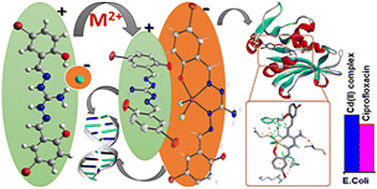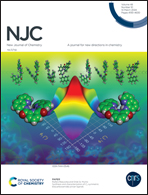An all-rounder aminoguanidine based ligand, its unusual anionic zinc(ii) and cadmium(ii) coordination complexes and their biological implications†
Abstract
Multipurpose coordination flexibility of a bioactive ligand 1,3-bis(5-bromo-2-hydroxyphenyl-methylideneamino)guanidine hydrochloride (H5Brsal-dag·HCl) is reported. The chelation of the ligand with Zn(II) ions after deprotonation forms an unusual anionic complex and as an all-rounder, the same ligand gets protonated and acts as a counter cation to produce the complex in good yield. We could synthesize and characterize an analogous Cd(II) complex also by following similar reaction conditions, which further confirms the high flexibility of the ligand and rules out serendipity. The molecular structures of [ZnCl2(H4Brsal-dag)]H6Brsal-dag·DMF·H2O (1) and [CdCl2(H4Brsal-dag)]H6Brsal-dag·DMF·H2O (2) are confirmed by single crystal X-ray diffraction, after characterization by physicochemical methods. The short-term in vitro cytotoxicity assessment against Dalton's Lymphoma ascite tumor cells reveals the efficacies of all the compounds. The antibacterial activity tested against Escherichia coli and Staphylococcus aureus revealed the potential of the complexes compared to the free ligand. The complex 2 is found to be more potent against E. coli than the standard ciprofloxacin. Density functional theory studies were also performed to ascertain the electronic properties, which are in agreement with different putative binding potentials and their efficacies. The Zn(II) complex is found to exhibit promising antioxidant potential and antitumor activity. The versatility of the ligand offers new perspectives in coordination chemistry.



 Please wait while we load your content...
Please wait while we load your content...